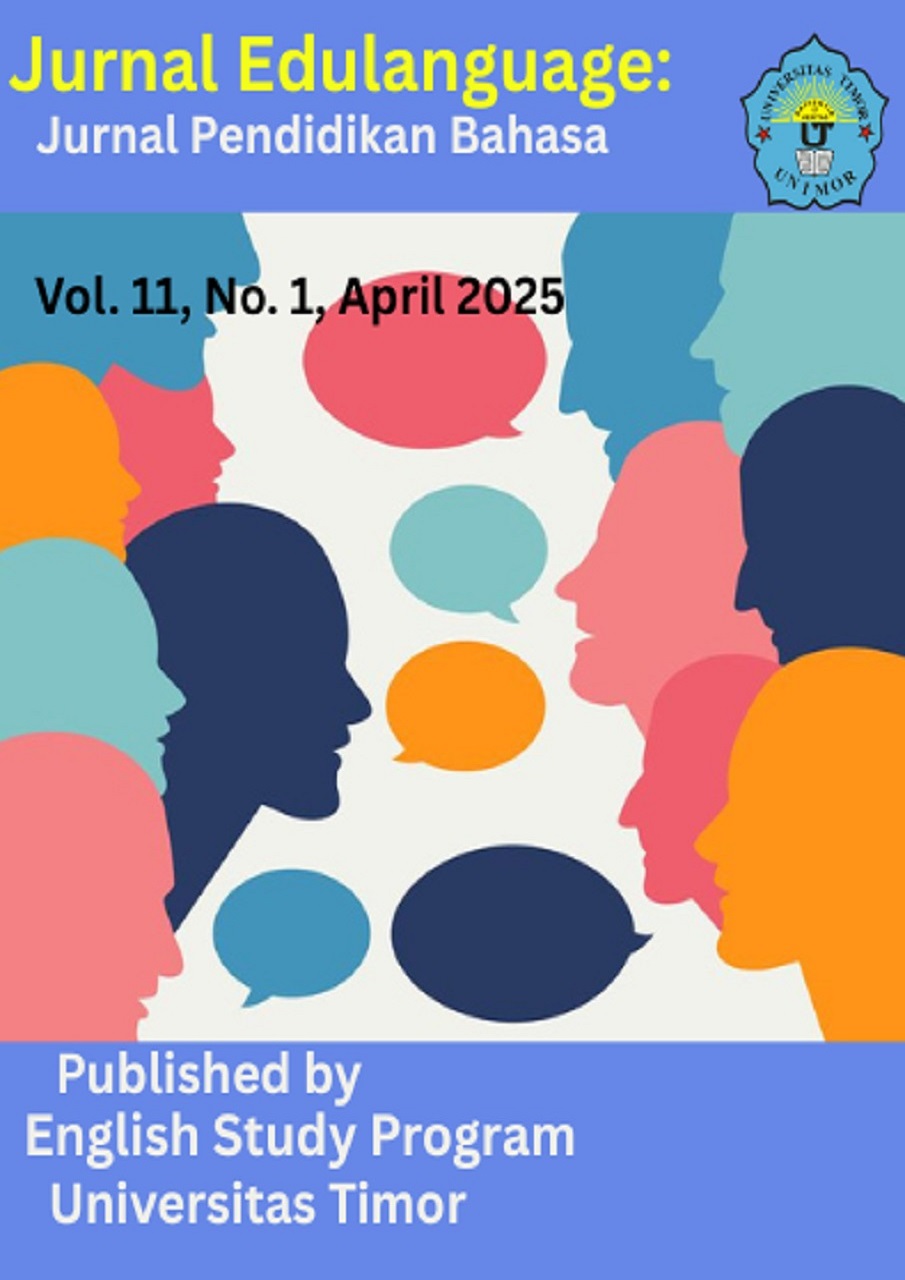An Analysis of Code Mixing and Code Switching Used by Students in English Education Department of Mathla’ul Anwar University Banten
DOI:
https://doi.org/10.32938/edulanguage.11.1.2025.25-46Keywords:
Code Mixing, Code switching, SociolinguisticsAbstract
Abstract is This study used a qualitative approach and descriptive-qualitative method to examine code-mixing and code-switching among sixth-semester students in the English Education Program at Mathla'ul Anwar University Banten during the 2022-2023 academic year. Five microteaching videos were analyzed. Data were collected through observation, documentation, and checklists. The study found that Subjects A to E used three types of code-mixing according to Hoofman’s theory: intra-sentential, intra-lexical, and mixing involving pronunciation changes. Based on Poplack’s theory, the types of code-switching observed were tag-switching, inter-sentential switching, and intra-sentential switching. Subject A showed the highest frequency of code-mixing with 30 instances (26 intra-sentential and 4 intra-lexical) and the highest frequency of code-switching with 30 instances (1 tag-switching, 14 inter-sentential, and 15 intra-sentential). Code-mixing and code-switching were influenced by bilingual or multilingual abilities, the need to fit social or situational contexts, and specific communication needs. The study suggested further research in sociolinguistics to better understand these phenomenon. The researcher hoped the findings would be useful for readers, students, and researcher interested in code-mixing and code-switching.
Keywords: Code Mixing, Code Switching and Sociolinguistics
References
Ahdal, A. A. M. H. (2020). Code mixing in Arabic conversations of college students: A sociolinguistic study of attitudes to switching to English. Asian ESP Journal, 16(11), 6–19.
Ansar, F. A. (2020). Code-switching in EFL classroom: A communication strategy. International Journal of English Language & Translation Studies, 8(1), 50-55.
Auer, P. (2021). Code-switching and code-mixing in bilingual communication. Cambridge University Press
Dewi, N. (2022). Enhancing student engagement through code-switching. Journal of English Teaching, 14(2), 112-127.
Elo, S., & Kyngäs, H. (2008). The qualitative content analysis process. Journal of Advanced Nursing, 62(1), 107-115. https://doi.org/10.1111/j.1365-2648.2007.04569.x
García, O., & Wei, L. (2018). Translanguaging: Language, bilingualism and education. Palgrave Macmillan.
García, O., & Wei, L. (2022). Translanguaging: Language, bilingualism and education. Palgrave Macmillan.
Gardner-Chloros, P. (2020). Code-switching: A sociolinguistic perspective. Cambridge University Press.
Gardner-Chloros, P. (2021). Code-switching: Attitudes and applications. Cambridge University Press.
Grosjean, F. (2018). Bilingual brain. Harvard University Press.
Gumperz, J. J. (2019). Discourse strategies. Cambridge University Press.
Halliday, M. A. K., & Martin, J. R. (2018). Language, knowledge and pedagogy: Functional linguistic and sociological perspectives. Bloomsbury Academic.
Hoffman, C. (1991). An introduction to bilingualism. Longman.
Krippendorff, K. (2019). Content analysis: An introduction to its methodology (4th ed.). SAGE Publications.
Luke, Y. J. (2015). The use of code-mixing among Pamonanese in Paratadaya Closed Group Facebook. Journal Lingua Cultura, 9(1), 40-46.
MacSwan, J. (2022). Code-switching in bilinguals: Theories and models. Routledge.
Maheswara, S. R. M. (2022). Analysis of code-switching and code-mixing exist in Rintik Sedu YouTube Channel’s video. Prasasti: Journal of Linguistics, 7(2), 172-180.
Muysken, P. (2018). Bilingual speech: A typology of code-mixing. Cambridge University Press.
Muysken, P. (2020). Bilingual speech: A typology of code-mixing. Cambridge University Press.
Muysken, P. (2021). Bilingual speech: A typology of code-mixing. Cambridge University Press.
Nugroho, B., Wulandari, T., & Pratiwi, R. (2021). Code-switching in language teaching: A pedagogical perspective. International Journal of Linguistics, 9(3), 78-92.
Poplack, S. (1980). Sometimes I'll start a sentence in Spanish y termino en Español: Toward a typology of code-switching. Linguistics, 18(7-8), 581-618.
Pratiwi, A., Nugroho, S., & Wulandari, T. (2022). Teachers’ perception of code-mixing in English language teaching. Journal of Applied Linguistics, 14(3), 201-215.
Putri, A., & Sari, D. (2020). The role of code-switching in EFL classrooms. Journal of Language Education, 5(1), 45-57.
Rahman, A., Dewi, N., & Lestari, M. (2020). The role of code-mixing in EFL classrooms: A pedagogical perspective. Journal of English Language Teaching and Learning, 10(1), 45-60.
Rohimajaya, N. A., & Hamer, W. (2022). An analysis of the appraisal framework “What the pandemic teaches us” in the newspaper of The Jakarta Post. International Journal of Research in Education, 2(2), 155–165.
Romaine, S. (2020). Bilingualism. Blackwell.
Sari, D. P., & Putri, Z. (2021). The role of code-switching in EFL learning contexts. Journal of Language and Education Research, 4(2), 120-130.
Setiawan, A. (2021). Code-mixing in EFL classrooms: A pedagogical perspective. Journal of Language Teaching Research, 8(2), 112-123.
Thomas, M. (2018). Code-mixing in Indonesian: A sociolinguistic perspective. Journal of Language and Society, 17(2), 11-30.
Wardhaugh, R., & Fuller, J. M. (2020). An introduction to sociolinguistics (8th ed.). Wiley-Blackwell.
Wedananta, K. A. (2020). Code-switching as a translanguaging to transfer cross-cultural understanding in English classroom: Teachers’ perception. International Journal of Linguistics, Literature and Culture, 6(1), 70–78. https://doi.org/10.21744/ijllc.v6n1.845
Wibowo, A. I., Yuniasih, I., & Nelfianti, F. (2017). Analysis of types of code-switching and code-mixing by the sixth president of the Republic of Indonesia's speech at the National of Independence Day. Journal Progressive, 12(2), 13-22.
Yule, G. (2018). The study of language (4th ed.). Cambridge University Press.
Downloads
Published
How to Cite
Issue
Section
License
Copyright (c) 2025 Jurnal Edulanguage: Jurnal Pendidikan Bahasa

This work is licensed under a Creative Commons Attribution-NonCommercial-ShareAlike 4.0 International License.
All material contained in this journal is protected by law. It is prohibited to quote part or all of the contents of this journal for commercial purposes without the approval of the editorial board of the Edulanguage journal. If you find one or more articles contained in the Edulanguage Journal that violate or have the potential to violate your copyright, please report it to us via email to the editor of the Edulanguage Journal. Formal legal aspects of access to all information and articles contained in this journal refer to the terms of the Creative Commons Attribution 4.0 license. All information contained in the Edulanguage Journal is academic in nature. Edulanguage Journal is not responsible for losses that occur due to misuse of information from this journal. The author has copyright and full publication of articles published in the Edulanguage Journal.








